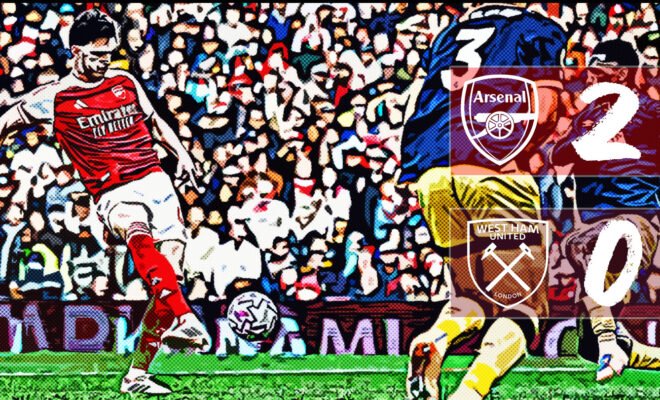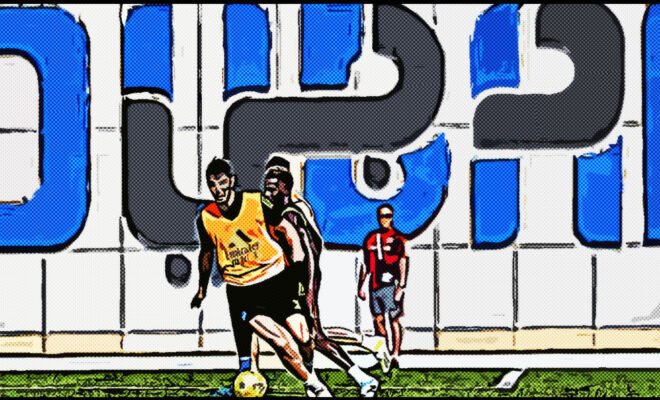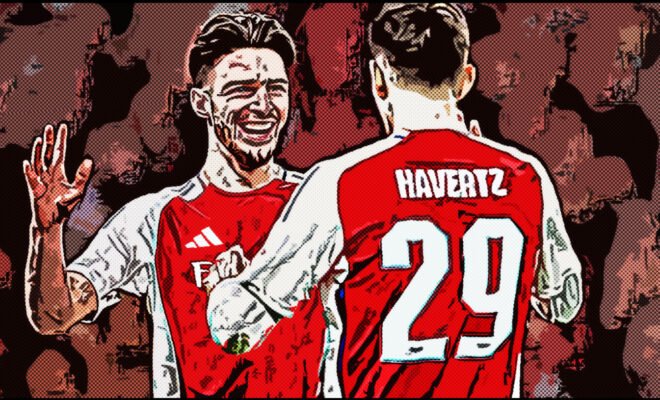Three Things We Learned as Arsenal Beat West Ham to Go Top of the Premier League

Mikel Arteta’s 300th match in charge arrived with a bit of edge. West Ham had nicked victories on their previous two league trips to the Emirates, each time bruising Arsenal’s title chase. This time the story was clear and controlled. Declan Rice struck on 38 minutes, Bukayo Saka added a penalty in the second half, and a 2-0 scoreline sent the home side into the international break with momentum and a clean sheet.
The numbers match the feeling inside the ground. Arsenal carried 69% possession, produced 21 shots to West Ham’s four, generated 3.4 xG including the spot kick against 0.8, and did not allow a single shot on target. The field tilted red for most of the day: 74% of final-third touches and territory belonged to the hosts. For a milestone match, this was an assertive, low-drama win that still offered plenty to learn about how Arteta wants this team to evolve.
Below are three lessons from the match analysis that matter for the weeks ahead.
Arsenal’s structure squeezed West Ham from minute one
Arteta started with an aggressive midfield blend, Martin Ødegaard and Eberechi Eze as dual advanced 8s with Rice initially deeper and the territorial control was immediate. Arsenal finished with 69.3% possession and a dominant 74.4% field tilt, reflecting how little of the game was played near David Raya. The pitch-control maps show Arsenal owning central lanes and both half spaces; West Ham’s touches clustered in their defensive third with only thin lines of progression.
The ball progression data explains why the visitors were pinned back. William Saliba led all players with 552 progressive yards carried or passed, Gabriel added 456, and Martín Zubimendi contributed 424 after entering early for the injured Ødegaard. Even the full backs served as playmaking hubs: Riccardo Calafiori logged 87 progressive yards and 28 touches in the final third; Jurrien Timber ended with 25 final-third touches and drew the foul for the penalty. When the center-backs and full backs break lines this often, opponents rarely climb up the pitch.
Arsenal’s pressing worked in tandem with that structure. West Ham were forced long and direct, rarely connecting passes through midfield. The measures-of-pressing chart shows passes-allowed-per-defensive-action dropping to low single digits during the decisive third quarter of the match, coinciding with Arsenal’s best chance creation. The Hammers produced four total shots and finished without a shot on goal, a clean sheet earned through control rather than emergency defending.
Chance quality supports the same conclusion. Non-shot xG, finished around 1.4 for Arsenal to 0.4 for West Ham, underlining how often the home side advanced into valuable spaces independent of the shots that followed. The open-play final-third threat map is even starker: Arsenal’s right half space and inside-left channels are dark red from repeated penetrations, while the West Ham equivalent is sparse.
What does that mean going forward? The method is portable. Against deeper blocks, Arsenal are at their best when the back line passes through pressure instead of playing around it. Saliba’s passing range, Gabriel’s stepping to the line, and the “second-midfielder” role Calafiori plays alongside the 6 make it hard to trap them. When opponents sit off, the red zones appear in the half spaces and the cut-back lanes are open. When opponents press high, Saliba and Raya can go over or through the first line. The model here was repeatable and did not rely on chaos or set-piece volume to create threat.
Two caveats surfaced. First, the scoreline under-sold the shot value: 3.4 xG produced just two goals. Second, Viktor Gyökeres again left without scoring. That leads to lesson two.
Saka and Rice delivered; Gyökeres still needs rhythm with the creators
The headline performances were from Arsenal’s leaders. Rice produced the opener, covered ground in both directions, and remained the best screen on the pitch. Saka marked his 200th league appearance by converting the penalty and leading chance creation on the day.
Saka’s creative line is elite by any measure. He led the team with five progressive passes, five deep completions and two key passes. His expected assists total (xA) was 1.37, the largest single figure in the match and he combined with Timber all afternoon to overwhelm Malick Diouf down West Ham’s left. The pass-completion heat map shows a dense network on the right edge of the area; many of those connections are Saka receiving between lines, finding the byline, or slipping inside for cut-backs.
Rice’s all-phase influence showed up across the tables. He logged four final-third entries, seven progressive carries, and two shots worth 0.31 xG besides the goal he actually scored from the rebound. His defensive work closed transition lanes before they formed;his defensive work resulted in interceptions and recoveries around the center circle and right half space where he throttled counterattacks. Even when Zubimendi came on and Rice moved higher, he continued to time runs beyond the first pressing line, something this side needs from one of the 8s when the center-forward pins defenders.
Zubimendi deserves a separate mention. He influenced both goals without collecting an assist. The first came from a delicate pass into Eze that Areola spilled; Rice followed in. The second started with a clipped ball to Timber that drew the foul for the penalty. Zubimendi topped the match for line-breaking passes despite playing only an hour, matched the leaders for final-third line-breaks, and then handled late defensive duties with clearances and positioning that killed West Ham’s rare turnovers. For a mid-half change forced by injury, this was a seamless shift that arguably improved the balance.
Now to Gyökeres. The striker’s drought reached six matches, which would be more worrying if the shot value had collapsed. It has not. He finished with 1.37 xG from two shots, both quality looks generated by Saka and Eze from cut-backs and square balls. The issue is timing and chemistry. Several first-half moves broke down because Gyökeres was flat to the line or arrived a step early, which either triggered an offside or narrowed the angle. The possession still benefits from his running, he drew markers away to free Saka and Trossard and he contributed one progressive pass and two box completions, but the final step is repeatable movement cues with Ødegaard/Saka when the ball enters the right half space.
On the other side, West Ham had little to claim. Lucas Paquetá carried their largest creative burden but without runners, and their total progressive passes reached only 12 compared with Arsenal’s 29. New manager Nuno Espírito Santo set a compact 4-1-4-1 and asked for counters down the right, yet the progressive-passing plot shows almost no completed long outlets that found a teammate in stride. The visitors finished with 0.8 xG, most of it from early set-piece moments and late scrambles.
The bigger picture: depth looks real, injuries are the only cloud
The larger takeaway stretches beyond the 90 minutes: Arsenal’s squad depth is carrying a heavy workload without dropping standards, but the injury list is growing again.
Start with depth. Ødegaard left on the half hour with a knee issue and Arsenal’s level did not dip. Zubimendi stepped in, moved Rice higher for a different look, and the team produced both goals after the reshuffle. Timber remains a force multiplier on the right, offering the overlap to free Saka and the inside seam to help progress into crowded zones. Calafiori gave another example of how a nominal left-back can operate as an auxiliary midfielder: 28 touches in the final third, five entries, and a right-footed effort off the post near the break. When Mikel Merino and Gabriel Martinelli arrived late, the team kept control without chasing a third; the bench is stacked with players who can either speed the game up or slow it down to a clean finish.
Then the cloud. Ødegaard’s stop-start month continued. The captain has now been forced off before half-time in three consecutive starts. Bukayo Saka, William Saliba and others have already carried heavy minutes through the opening block. The performance metrics show a team that can dominate with different midfield combinations, but the title race will test availability as much as quality. The schedule after the break accelerates, and the rhythm between Gyökeres and the creators will benefit from continuity that injuries disrupt.
The match also hinted at a strategic evolution. Arteta has leaned into fluidity between the 6 and the full backs, and he is giving the team multiple ways to station a second playmaker near the base of midfield. Against West Ham he began with Rice alone as the 6 and two attacking 8s, then shifted to a double pivot feel with Zubimendi plus Rice higher, and later closed with Merino to lock the center. Across those phases Arsenal still produced territory, pressing, and chance quality. That flexibility is the hallmark of a mature side and offers protection when injuries force tweaks.
From a league lens, clean sheets remain a trend. Defensively, Arsenal are absorbing pressure high in the middle third, but allowing few touches near the Arsenal box; David Raya spent long stretches with a spectator’s view. Seven clean sheets in the opening 10 across all competitions have come from exactly this pattern: prevent entries, not just shots. West Ham’s 0 shots on target were not a fluke; they are the product of a defensive structure that is active long before a team can get near the penalty area. .
Conclusion
Arsenal’s 2-0 against West Ham was more than a milestone for the manager. It was a tidy picture of how this version of the team intends to control matches: dominant field position, back-line distribution that breaks lines, and sustained pressure that turns into shot volume and high-value chances. The final count: 21 shots, 3.4 xG including the penalty, 69% possession, aligns with the visual story of the afternoon.
From the player lens, Rice and Saka drove the result. Rice’s box-to-box range and Saka’s end-product combined with Zubimendi’s passing to create and then kill the game. Gyökeres’ drought is the one unresolved note, yet his two high-value chances and the service numbers around him suggest a finishing uptick is close once the timing with Saka and the right-side combinations clicks. The data supports patience rather than panic.
The larger season takeaway is double-edged. Depth is real; the squad can handle reshuffles without losing control of matches. Injuries are the only force that can derail the rhythm. The next block after the break will ask for careful load management, while maintaining the same aggressive structure that suffocated West Ham.
Call it a routine win, but use it wisely. The Premier League campaign rewards teams that collect points exactly like this, emphatic in performance, safe in game state, and rich with clues about what travels to tougher grounds. Arsenal leave the day with three points, a cleaner blueprint for the midfield puzzle, and another reminder that they can dictate matches through method rather than chaos. For a club intent on staying in the title conversation, that might be the most valuable lesson of all.
Leave a reply
You must be logged in to post a comment.







